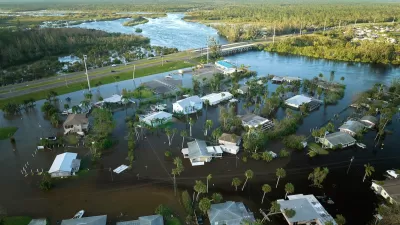A new report out this week quantifies the federal government's escalating disaster relief spending, a sum that hadn't previously been tabulated and came as a surprise to many.
"Hurricanes, floods and droughts are putting an increasingly large strain on the federal budget," reports Brad Plumer. "A new report out Monday from the Center for American Progress finds that Congress spent at least $136 billion on disaster relief between 2011 and 2013."
"Big, costly natural diasters appear to have become more frequent in the United States over the past few decades. According to the National Oceanic and Atmospheric Administration, the number of severe weather events that inflict at least $1 billion in damage (adjusted for inflation) has risen from an average of two per year in the 1980s to more than ten per year since 2010," he adds.
"There are several reasons for the rise in billion-dollar events, experts say. The U.S. population is growing, so more people live in coastal regions, on floodplains, in fire-prone forest areas, and in other high-risk places. The country is also getting wealthier, so there are pricier homes and costlier infrastructure that get damaged in floods, storms, and fires."
"But climate change has also altered at least some weather patterns."
FULL STORY: The government is spending way more on disaster relief than anybody thought

Planetizen Federal Action Tracker
A weekly monitor of how Trump’s orders and actions are impacting planners and planning in America.

Chicago’s Ghost Rails
Just beneath the surface of the modern city lie the remnants of its expansive early 20th-century streetcar system.

San Antonio and Austin are Fusing Into one Massive Megaregion
The region spanning the two central Texas cities is growing fast, posing challenges for local infrastructure and water supplies.

Since Zion's Shuttles Went Electric “The Smog is Gone”
Visitors to Zion National Park can enjoy the canyon via the nation’s first fully electric park shuttle system.

Trump Distributing DOT Safety Funds at 1/10 Rate of Biden
Funds for Safe Streets and other transportation safety and equity programs are being held up by administrative reviews and conflicts with the Trump administration’s priorities.

German Cities Subsidize Taxis for Women Amid Wave of Violence
Free or low-cost taxi rides can help women navigate cities more safely, but critics say the programs don't address the root causes of violence against women.
Urban Design for Planners 1: Software Tools
This six-course series explores essential urban design concepts using open source software and equips planners with the tools they need to participate fully in the urban design process.
Planning for Universal Design
Learn the tools for implementing Universal Design in planning regulations.
planning NEXT
Appalachian Highlands Housing Partners
Mpact (founded as Rail~Volution)
City of Camden Redevelopment Agency
City of Astoria
City of Portland
City of Laramie




























